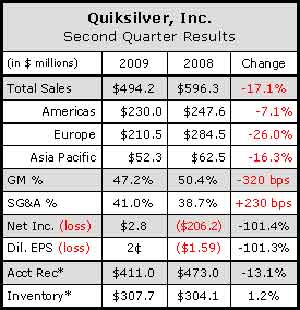
Quiksilver, Inc. swung to a profit in the second fiscal quarter ended April 30, but the Q2 rebound seemed almost an afterthought as management laid out a three-part financial restructuring plan that includes a $150 million loan from Rhone, a private equity firm with offices in London, New York and Paris that specializes in leveraged buy-outs of trans-Atlantic and pan-European businesses.
Quiksilver management said the new capital provided by the loan will “significantly improve the companys liquidity position and is expected to provide the cornerstone to solidify Quiksilvers regional banking relationships around the world.” The five-year senior secured loan includes about $25.6 million in warrants that can be converted into shares of common equity at or above the 60-day weighted average stock price of $1.86. Approximately $82 million of the loan will be accounted for as debt while the remaining $68 million will be attributed to warrants and classified as equity on the balance sheet.
Quiksilver also added two of Rhones co-founders to the companys Board of Directors.
The second component of the recapitalization plan is a new $200 million asset-based lending facility from Bank of America and GE Capital to refinance the companys existing Americas facility in the form of a new three-year credit facility. Thirdly, the company is also in discussions with French banking partners to consolidate its European debts into a new committed multi-year facility.
Management, who said in a prior conference call that they were considering the sale of one of their three brands (Quiksilver, Roxy, DC) to improve liquidity, confirmed that the new financing would enable them to retain all of their brands. Likewise, Bob McKnight, president and CEO, said during the second quarter conference call with analysts that the plan would allow senior management to turn its focus on driving change though the organization. “In hindsight,” McKnight admitted, “we probably pushed the businesses too hard to compensate for the losses in hardgoods, and as a result, our profit margins and returns on capital suffered.”
Quiksilver, which returned to profit after a year-ago loss that was impacted by several steep costs related to the separation of the Rossignol business, saw revenues from continuing operations fall 17.1% to $494.2 million from $596.3 million in the year-ago period. In constant currency, revenues declined 8% for the period.
Net income, which was $2.8 million, or two cents per diluted share, as compared to a net loss of $206.2 million, or $1.64 per diluted share, in the year-ago period, was impacted by “negative traffic trends along with the incremental expenses related to the restructuring
”
Regarding brand performance, management said DC, which was led by strength in Europe, was up overall while Quiksilver and Roxy were up in the Asia-Pacific and down in all other regions.
Impacting consolidated revenues was a 7% decline in the Americas, which management attributed to negative retail store comps and the closure of four stores throughout the fiscal year. Management added that the wholesale business in the Americas contracted less than the retail side, but a mixed shift towards discounted product sank overall results in the region.
European revenues in terms of constant currency fell 13% on a low-double-digit comp decline while revenues in the Asia-Pacific region were up 14% in constant currency due to the inclusion of the Japanese business in the region.
Quiksilver opened a total of 28 net new shops over the last year, including nine in the second quarter.
Overall gross margin, which decreased 320 basis points to 47.2% of sales for the second quarter, was largely affected by discounting in the U.S., said management. Likewise, spring-summer margins for Quiksilver and Roxy benefited from “sourcing improvements,” but were largely offset by customer discounts.
Management added that “given the sudden downturn in the environment, we were not able to reduce our spring and summer buys early enough.” As a result, management noted the company “(has) some excess goods to move through” and will liquidate as “hard and fast as (it) can do responsibly.”
Regarding outlook, the company projects Q3 revenues to be down in the mid-teens on a percentage basis and forecasts margins to contract by around 400 basis points based on price discounting. Cost-cutting measures are expected to drive down SG&A, but management expects costs to be up 75 to 100 basis points as a percentage of sales due to a reduced sales level. EPS are expected to be down low-singles for the third quarter.
Management noted that 160 positions will be eliminated by the end of July as part of the final phase of the t-shirt production facility closure and distribution center consolidation.















